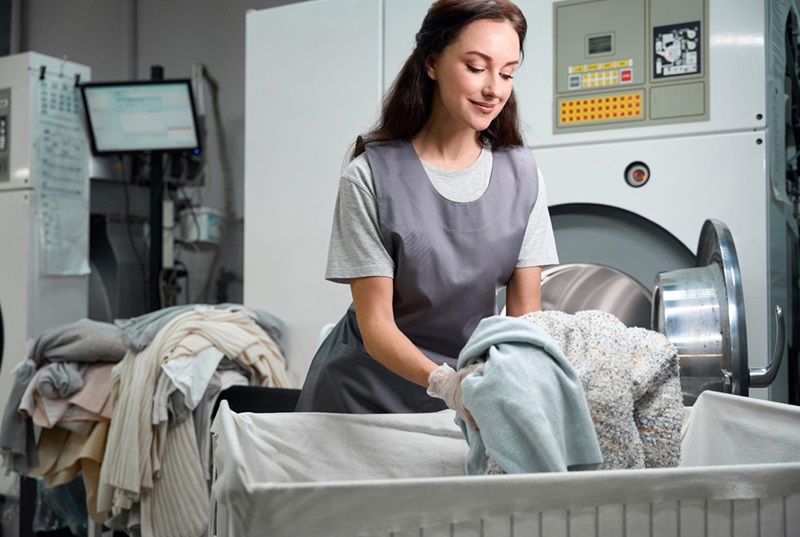From Dirty to Fresh: A Closer Look at the Lavanderia Industry

In our increasingly busy and fast-paced world, laundry services have become virtually indispensable. They help us save valuable time and assure a high level of cleanliness and hygiene.
Importance of laundry services in our daily lives
Firstly, the regularity and convenience offered by laundry services whisk away the headaches synonymous with laundry-related chores. A professional laundry service can accommodate large volumes of washing, saving individuals and businesses considerable time and energy.
Moreover, it can offer valuable expertise in treating different fabrics and stains.
Secondly, proper and meticulous cleaning provided by laundry services is a significant health benefit.
Dirty clothes can be a perfect environment for bacteria and germs to thrive. Professional laundry services prioritize hygiene to maintain the highest standards, particularly in healthcare settings where clean linens are crucial in minimizing the risk of infection.
Overview of the Lavanderia industry
The lavanderia industry has grown considerably worldwide, driven by an expanding customer base and technological advancements. It is a multifaceted industry that caters to both commercial and residential needs.
Commercial laundry services help hospitals, hotels, and restaurants with bulk laundry, while residential laundry services help households with daily laundry.
The industry has many business models, from brick-and-mortar laundromats to app-based wash-and-fold services.
It is an industry that is not bound by status or class, providing services to everyone, from students living in dormitories to busy urban professionals, large families, and many others.
Evolution of the Lavanderia industry over time
The lavanderia business has changed a lot over the years, along with technology and social changes.
This journey is marked by impressive developments, from harsh washing methods on river banks to detailed and meticulous processes backed by high-tech machinery.
Early laundries relied on manual labor and rudimentary equipment. As industrialization progressed, laundry services grew in scale and efficiency. They began using large, steam-powered washing machines and conveyor systems to handle high volumes of laundry.
With the advent of the 20th century, the industry saw the emergence of self-service laundromats. They provided a more convenient and cost-effective alternative for the general public.
The mid to late 20th century brought significant technological advancements, including computerized machines that promoted energy and water efficiency.
In recent years, the lavanderia industry has been revolutionized by digital technology. Online platforms and mobile apps have streamlined customer interaction, scheduling, and payment services.
Furthermore, eco-friendly practices and sustainability have gained momentum within the industry.
Today’s service providers are focusing on using biodegradable detergents, energy-efficient machines, and water conservation practices to ensure they clean clothes and contribute to a cleaner environment.
The laundry sector plays a major role in our daily lives and has a big effect on the economy.
Its commitment to innovation, ability to adapt to changing customer needs, and technological advances position it to remain relevant and essential.
Types of Lavanderia Businesses
The lavanderia industry is diverse and encompasses several different types of services that effectively cater to customers’ different needs.
Self-service Lavanderias: These are typically coin-operated laundromats where customers handle their laundry themselves. It’s a cost-effective solution for those not mind investing some time in processing their laundry.
Full-service Lavanderias: This service encompasses everything from washing and drying to folding. The customer just drops off their laundry and picks it up when it’s ready. Full-service lavanderias are perfect for busy individuals who prefer convenience over cost.
Mobile Lavanderias: A relative newcomer in the industry, mobile lavanderias are entering alongside digital advancements. They offer flexible pickup and laundry delivery directly from and to the customer’s home or office.
Laundry Process and Techniques
In professional lavanderias, the laundry process is rather elaborate:
- Sorting: Clothes are first sorted based on their color, fabric, and cleaning instructions.
- Pre-treating Stains: Stains are pre-treated before washing to ensure better results.
- Washing: Clothes are washed in industrial-grade washing machines with appropriate detergents and fabric conditioners.
- Drying: The washed clothes are dried using commercial dryers or air-dried based on the fabric’s requirements.
- Ironing and Folding: Lastly, the clothes are professionally ironed and meticulously folded, ready for pick-up or delivery.
This entire process ensures each garment receives the care it deserves and comes back to the customer clean, crisp, and looking its best.
Equipment and Technology Used in Lavanderias
Modern lavanderias utilize a range of highly specialized equipment to deliver their services.
Machines include commercial-grade washers and dryers, ironing systems, automated clothes folding machines, and stain-removal equipment.
Many businesses now incorporate technologies like machine learning and automation to improve operations and provide better customer experiences.
As an example, smart laundromats can offer customers real-time updates on machine availability or estimated finishing times through a mobile app.
Establishing a Friendly and Cozy Environment for Customers
An essential aspect of running a successful lavanderia in Houston is creating a welcoming ambiance.
Comfortable seating areas, free Wi-Fi, and a neat, clean environment can genuinely enhance the customer experience. Self-service lavanderias often provide entertainment options like televisions or book exchanges to make laundry times less tedious.
Diversification of Services
Adding more services has become an essential way for laundromats to grow in today’s fast-paced market. By offering more services, you can not only make customers happier, but you can also make more money.
Dry Cleaning: An essential add-on service preferred for delicate garments that cannot withstand regular washing.
Ironing: Some customers appreciate the convenience of pressing their clothes, saving time and effort.
Alterations: Providing minor repair or alteration services like button attachment, hemline adjustments, or mending small tears adds value for customers.
Linen and upholstery cleaning: Cleaning household items such as bed linens, curtains, and rugs broadens the customer base, accommodating their varied needs.
The evolution of the lavanderia industry also reflects how our society has evolved, both technologically and socially. The future will likely bring further advancements like environmentally sustainable practices or AI-powered sorting and folding technologies, continuing to transform and redefine the industry.